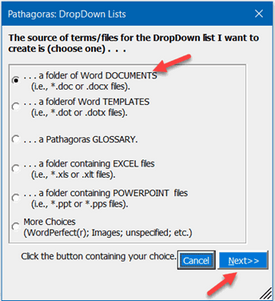Creating 'Free Hand'
You are most likely to create your first DropDown List ‘freestyle:’ In other words, you will manually navigate to source content for the List.
In the Pathagoras tab, click button (the 5th from the left) that is titled 'DropDown Lists.'
An alternative starting point for creating a DropDown List is the 'Create DropDown List' element in the Pathagoras features menu.
. Follow the prompts, which will ask you to:
•Select the type of content you want the DropDown List to contain. While you will have many choices, for most instances you will select the first option, 'Word Documents'.
•You will next be asked HOW you want to select the target folder of documents. Unless you know the others apply, select the first option: 'I will navigate.'
•Navigate to INSIDE OF the folder that contains the files that you wish to be inserted into the DropDown List. (By folder, we are referring to any standard Windows folder that already exists on your computer or across your network.) Select one item in the folder (it doesn't matter which one -- you are locking in the folder, not the selected document) and press OK.
•(If your target source is a Pathagoras Glossary, navigate to, and simply select, the Glossary you desire. Press OK.)
•When prompted, give the list a title. The default title will be the name of the selected folder or glossary. But feel free to name it anything you wish.
•After you have created your first DropDown List, you will be offered one more options -- where to place the list. "Add second (third, etc.)' or 'Replace' an existing list. Make the appropriate choice. (Tray 1 refers to the top row of Lists, up to 5, and Tray 2 refers to the lower row of Lists, up to 5.) If this is your first list, no 'where' question is posed.
•That is all! In just a few seconds, you will see the DropDown List, containing the content of the folder or glossary in the DropDown List area.
OTHER COMMENTS and LIMITATIONS:
•The above steps assumed your DropDown List would reflect documents in a folder. But when you display the 'Type of List' screen, note the great variety of items a List can contain. Note also that there is a second page of options. Don't hesitate to experiment with different kinds of Lists.
•Because a DropDown List is so easy to create, delete and recreate, don’t get ‘hung up’ on which folder or glossary you select for your first one. You have 10 readily available (and 40 in total if you implement 'Collections'). You can overwrite any of them at will. Just do it!
•Pathagoras doesn’t care whether a DropDown List contains links to complete documents, to individual clauses, to pictures, spreadsheets, PDF files, or whatever. If Word has the capacity to insert a particular file type, it can be the contents of a DropDown list. We recommend that you experiment with many types of Lists.
•A DropDown List must point to a lettered drive (or subfolder beneath it). It cannot point to a network designator of that same location. So as you are navigating to the location of the folder, use the assigned letter under "This PC' and not the 'Network' link. (They point to the same place, but Pathagoras cannot use the typical "\\network\my documents . . ." address, but rather needs the classic letter designators, e.g., "n: \office forms\. . . ." If a letter has not yet been assigned to the drive, check with your IT person (or Google 'assign drive letter to OneDrive') to see how to accomplish this.
See Also:




